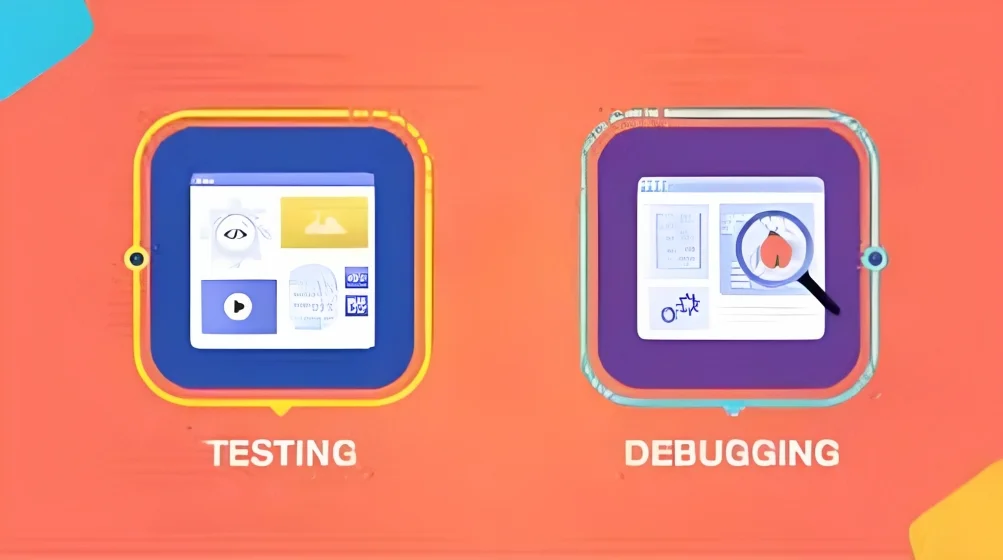How to Test and Debug Your Web and App Projects Effectively
The significance of ensuring the quality and functioning of your products cannot be stressed enough in the fast-paced world of online and application development. In this process, testing and debugging are essential because they let you find and fix problems before they affect your consumers.

Introduction to Testing and Debugging
Before we delve into the intricacies of testing and debugging, let’s clarify their definitions. Testing involves systematically checking different aspects of your web and app projects to ensure they function as intended, while debugging refers to the process of identifying and fixing errors and defects found during testing.
Both testing and debugging are indispensable steps in the software development life cycle. They help ensure a smooth user experience, improved performance, and overall customer satisfaction. So, let’s dive right into the AIDA formula to effectively test and debug your projects.
Recognizing the Value of Testing
The first step in successful testing and debugging is to grasp the significance of a thorough examination. Testing is a crucial stage that may make or break your online and app initiatives, it is not just a formality. Your goods must perform effectively across devices, browsers, and operating systems to give the optimal user experience.
Types of Testing for Your Projects
There are various types of testing, each serving a unique purpose in evaluating different aspects of your web and app projects.
Some important testing methods include.
Functional Testing
Functional testing validates if your web and app projects fulfill the intended functionality. It guarantees that all features and parts function as intended, delivering a smooth user experience.
Performance Testing
Performance testing evaluates how well your projects perform under various conditions. This testing includes load testing, stress testing, and scalability testing to assess system responsiveness and stability.
Compatibility Testing
Compatibility testing checks your projects across different devices, browsers, and operating systems to ensure consistent functionality and appearance for all users.
Security Testing
Security testing is vital in today’s digital landscape. It identifies potential vulnerabilities and ensures that your projects are safeguarded against security threats.
Usability Testing
Usability testing involves gathering feedback from users to assess the user-friendliness and ease of navigation of your web and app projects.
Building Effective Test Cases
To conduct comprehensive testing, you need well-defined test cases that cover all aspects of your web and app projects.
Here’s how you can build effective test cases.
Requirements Analysis
Thoroughly analyze the requirements and functionalities of your projects to create test cases that align with their objectives.
Test Data Preparation
Prepare relevant test data that represents various scenarios to simulate the real-world usage of your projects.
Test Case Design
Design test cases with clear steps, expected outcomes, and prerequisites for execution.
Prioritization
Prioritise test cases based on risk assessment and the criticality of features.
Executing the Testing Process
It is time to put your well-written test cases into action and carry out the testing procedure now that you have them.
Follow these steps for effective execution.
Test Environment Setup
Set up a controlled and isolated test environment to avoid interference from external factors.
Test Execution
Execute the test cases and meticulously record the results, including any defects encountered.
Defect Reporting
Report defects promptly and comprehensively, including detailed steps to reproduce the issues.
Regression Testing
After fixing defects, perform regression testing to ensure that new changes do not adversely impact existing functionalities.
Debugging Your Projects
The debugging phase is where you identify and eliminate the defects and issues discovered during testing.
Here’s how to effectively debug your web and app projects.
Log Analysis
Examine log files to identify potential errors and their root causes.
Divide and Conquer
Isolate the problematic areas by dividing the codebase into smaller segments, making it easier to identify the root cause.
Automated Debugging Tools
Utilise automated debugging tools and software to assist in identifying and fixing errors.
Collaborative Debugging
Encourage collaborative efforts among developers to brainstorm solutions and resolve complex issues.
Best Practises for Effective Testing and Debugging
To optimize your testing and debugging processes, Consider the following best practices.
Early and Continuous Testing
Start testing early in the development cycle and continue throughout the process to catch issues as soon as possible.
Test in Real-World Scenarios
Simulate real-world scenarios during testing to ensure your projects can handle various user interactions.
Automate Testing
Automate repetitive tests to save time and effort, allowing your team to focus on more complex aspects of testing.
Document Everything
Maintain comprehensive documentation of test cases, test results, and debugging processes for future reference.
Monitoring and Feedback Loop
Even after the initial testing and debugging phases, it is essential to implement a monitoring and feedback loop to continuously improve your web and app projects. This process involves collecting and analyzing user feedback, monitoring performance metrics, and promptly addressing any issues that arise.
User Feedback Collection
Encourage users to provide feedback through surveys, reviews, and feedback forms. Analyze this feedback regularly to gain insights into user satisfaction and identify potential areas for improvement.
Performance Monitoring
Implement monitoring tools to track key performance indicators (KPIs) such as response times, error rates, and resource utilization. Proactively address any performance bottlenecks to enhance the user experience.
Bug Tracking
Continue to track and manage reported bugs and issues to ensure they are resolved promptly and efficiently.
Test Automation Frameworks
To streamline the testing process and enhance efficiency, consider adopting test automation frameworks. These frameworks allow you to automate repetitive tests and perform large-scale testing with ease.
Selenium
Selenium is a popular open-source automation testing tool that supports multiple programming languages. It provides robust capabilities for web application testing, enabling you to execute tests across different browsers and platforms.
Appium
Appium is an automation tool specifically designed for mobile app testing. It is a great option for cross-platform app testing because it supports both the Android and iOS operating systems.
Cypress
Cypress is a potent framework for end-to-end testing of online applications. Its ability to perform testing in real time and its straightforward syntax make it a favorite among developers.
Utilizing CI/CD
The development methodologies of continuous integration (CI) and continuous deployment (CD) encourage regular code integration, testing, and deployment. By embracing CI/CD, you can streamline the testing and debugging process and deliver updates and features more rapidly.
CI: Frequent Code Integration
Frequent integration of code updates into the primary codebase will guarantee that the team is working with the most recent version.
Automated Testing in CI/CD
Automate testing within the CI/CD pipeline to validate code changes automatically. This ensures that new code additions do not introduce critical bugs.
CD: Automated Deployment
Implement automated deployment to release new updates and features to production efficiently and reliably.
Load Testing for Scalability
Load testing is a crucial part of performance testing that assesses how well your web and app projects handle user traffic under heavy load. By conducting load testing, you can ensure your projects can scale to meet the demands of a growing user base.
Setting Realistic Load Scenarios
Simulate real-world scenarios during load testing to understand how your projects perform under various conditions, such as peak traffic periods.
Identifying Performance Bottlenecks
Analyse load testing results to identify performance bottlenecks and areas that require optimization.
Load Testing Tools
Utilise load testing tools like JMeter, LoadRunner, or Gatling to conduct comprehensive load tests.
Security Testing for Robust Protection
Security is a top priority in web and app development. Security testing helps identify vulnerabilities and ensure that your projects are well protected against potential threats.
Vulnerability Scanning
Conduct vulnerability scanning to detect common security issues and potential entry points for attackers.
Penetration Testing
Perform penetration testing to assess the robustness of your project’s security measures by simulating real-world attacks.
Security Automation
Utilise automated security testing tools to enhance efficiency and coverage in identifying potential vulnerabilities.
Implementing Beta Testing for User Feedback
Beta testing is an invaluable stage in the development process that involves releasing a pre-release version of your web or app projects to a select group of users for real-world testing. Leveraging beta testing allows you to gather valuable feedback and identify any last-minute issues before the official launch.
Selecting Beta Testers
Choose a diverse group of beta testers that represent your target audience to obtain a wide range of perspectives and insights.
Gathering Feedback
Encourage beta testers to provide detailed feedback on their experiences with your projects, including any bugs or usability issues they encounter.
Addressing Feedback
Act upon the feedback received during the beta testing phase, making necessary improvements and bug fixes based on the testers’ input.
Regression Testing for Code Stability
As your web and app projects evolve with new features and updates, performing regression testing becomes essential. Regression testing ensures that new changes do not inadvertently introduce new bugs or negatively impact existing functionalities.
Creating Regression Test Suites
Build comprehensive regression test suites that cover critical features and functionality across your projects.
Automated Regression Testing
Automate the execution of regression tests to save time and effort during each development cycle.
Version Control
Implement version control to keep track of code changes and simplify the process of reverting to a stable version if necessary.
Cross-Browser and Cross-Device Testing
With the diversity of browsers and devices available, it’s crucial to test your web and app projects across various platforms to ensure consistent performance and user experience.
Browser Compatibility Testing
Test your projects on popular browsers such as Chrome, Firefox, Safari, Edge, and others to verify consistent functionality.
Device Compatibility Testing
To make sure it has the design is responsive, test it over all kinds of platforms, like laptops, tablets, desktop computers, and mobile devices.
Responsive Design Testing
Verify that your web projects display correctly on different screen sizes and orientations.
Performance Optimisation
Optimizing the performance of your web and app projects is essential for delivering a seamless user experience.
Here are some key strategies for performance optimization.
Minimise HTTP Requests
Reduce the number of HTTP requests by optimizing and combining CSS and JavaScript files.
Compress Images
Compress image files to reduce their size without compromising quality, improving load times.
Caching
Implement caching mechanisms to store frequently accessed data, reducing server load and improving response times.
Content Delivery Network (CDN)
Utilize a CDN to distribute content across servers worldwide, reducing latency and enhancing global accessibility.
Usability Testing for User Satisfaction
Usability testing is an integral part of user-centric development, helping you understand how users interact with your web and app projects and identifying areas for improvement.
User Flow Analysis
Analyse user flows to identify any potential bottlenecks or confusing navigation paths.
A/B Testing
Conduct A/B tests to compare different variations of design elements and functionalities to determine the most effective approach.
Accessibility Testing
Ensure your projects are accessible to all users, including those with disabilities, by conducting accessibility testing.
Conclusion
Effective testing and debugging are non-negotiables in the world of web and app development. You may assure the caliber, effectiveness, and security of your projects by adhering to the AIDA formula and putting the solutions described in this manual into practice. Remember, thorough testing leads to reliable products and satisfied users, ultimately contributing to the success of your business. Embrace testing and debugging as integral parts of your development process, and your web and app projects will stand out in today’s competitive digital landscape.
You will be considered well on your approach to developing outstanding web and app projects that will have an extended impact on the people who use them if you include these best practices in the way you develop them.
Happy Testing And Debugging!


